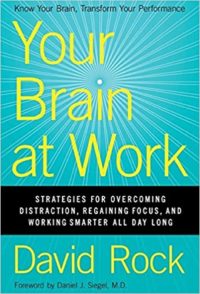Resources
Join our webinar Quick Fixes for Virtual Meeting Pitfalls on Thursday, June 4, 2 pm to 3 pm Eastern time. It’s free! You learn many more tips for making your meetings less fatiguing and more successful.

Check out Your Brain at Work: Strategies for Overcoming Distraction, Regaining Focus, and Working Smarter All Day Long by David Rock. The title says it all!
Virtual Meetings: 3 Pitfalls, 3 Easy Fixes
Some of the causes of “Zoom fatigue”—which apply no matter which online meeting platform you use—are built into the technology.
But many of the things that frustrate people about online meetings are things the facilitator can control, or at least ameliorate. Here are three.
1. Too much Zooming
This problem is also common in person: Lots of meetings just don’t need to be meetings!
Meetings are good for building consensus and for making decisions.
Work that supports consensus and informed decisions can be done in other ways.
- To gather information and participant opinions, use a survey.
- To brainstorm, use a shared document.
- To assign and track tasks after initial decisions have been made, use a shared tasking tool.
- To share information, send an email.
Save meetings for the important stuff that requires hearing everyone’s voice in real time.
2. Scattered attention
Let’s get the obvious issue out of the way first: No one needs to listen to anyone else’s background noise. As the meeting host, you have the power of the mute button. Don’t be afraid to use it.
A more subtle issue is the distraction of trying to track 20 faces in tiny boxes. Neuroscience suggests that this is a potent source of “Zoom fatigue.” When the CEO is talking, you want everyone’s attention focused just on the CEO’s box. So use the video equivalent of the mute button: Turn off everyone else’s video so the CEO gets the full screen. That’s right, turn them off. Don’t just use the speaker view. When you have a center of attention, only that person’s video should be on.
Another issue, which also applies to in-person meetings, is that our brains are good for about 20 minutes of any given activity. After that, they look for something new to do, like trying to read the titles on the books behind the CEO.
Limited attention span is often thought to be the culprit. That’s partly right, but it’s more about the limitations of working memory. Picture a stage — not at Carnegie Hall but at a preschool. The stage can fit only a few characters at a time. The more crowded it gets, the more characters are likely to fall off. When the crowd on the Zoom stage gets bigger, our brains look for a single thing to attend to. (Source: Your Brain at Work)
The solution is to “chunk” content into 10- to 20-minute segments: 10 minutes of the CEO’s presentation, 15 minutes of small-group discussion of the CEO’s points, 15 minutes of report-out and large-group discussion, and so on. And yes, chunking can also help with Pitfall 1.
3. Chat chaos
Chat is a useful tool when the facilitator uses it to forward the meeting agenda.
Left to their devices (literally), participants often choose unhelpful ways to use chat. YouTube videos and snarky comments — which smart users share only with individuals — are the tip of the iceberg. More substantive misuses of chat occur, for example, when introverts use it to avoid participating orally or when grandstanders “add their insights” to show how much they know.
You can’t stop people passing notes to each other. You can, however, say that you will tell them when to use chat. For example, you might have participants use chat at specific points to:
- React to what the presenter has been saying: “Enter one word that describes what you’re thinking about this.”
- Indicate where they are in a process: “On a scale of 1 to 5, how close to done do you think we are?”
- Enter questions: “As I go through these slides, please write your questions in chat. I’ll stop at a natural break point to answer them.”
Bottom line
For all three of these issues, the key to success is facilitator control. As I’ve pointed out before, facilitators of online meetings have to be more directive about process while staying neutral about content. On that small stage/screen, you are the director!
A pandemic is a great time to do something different. You may never have a more willing audience for breaking down the “I hate meetings” habit than you do right now. I invite you to get creative — and let me know how it’s going!
What you can do today
When you are a participant (not host/facilitator) in an online meeting, notice what most annoys you (outside of the fact that Harry just refuses to mute when his dog barks). Think about how you would address this problem if you were facilitating.
Question for discussion
What’s your biggest pet peeve about online meetings? If you’ve found a fix, please share it.


